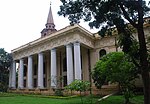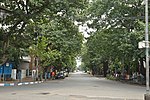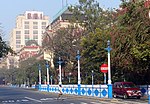B. B. D. Bagh
Central business districts in IndiaNeighbourhoods in KolkataPages with non-numeric formatnum argumentsRoad junctions in IndiaSquares in India ... and 2 more
Tourist attractions in KolkataUse Indian English from September 2018

B. B. D. Bagh, formerly called Tank Square and then Dalhousie Square (1847 to 1856), is the shortened version for Benoy-Badal-Dinesh Bagh. It is the seat of power of the state government, as well as the central business district of Kolkata in Kolkata district in the Indian state of West Bengal.
Excerpt from the Wikipedia article B. B. D. Bagh (License: CC BY-SA 3.0, Authors, Images).B. B. D. Bagh
Old Court House Street, Kolkata B. B. D. Bagh (Kolkata)
Geographical coordinates (GPS) Address Nearby Places Show on map
Geographical coordinates (GPS)
| Latitude | Longitude |
|---|---|
| N 22.572 ° | E 88.349 ° |
Address
B.B.D. Bag
Old Court House Street
700069 Kolkata, B. B. D. Bagh (Kolkata)
West Bengal, India
Open on Google Maps








